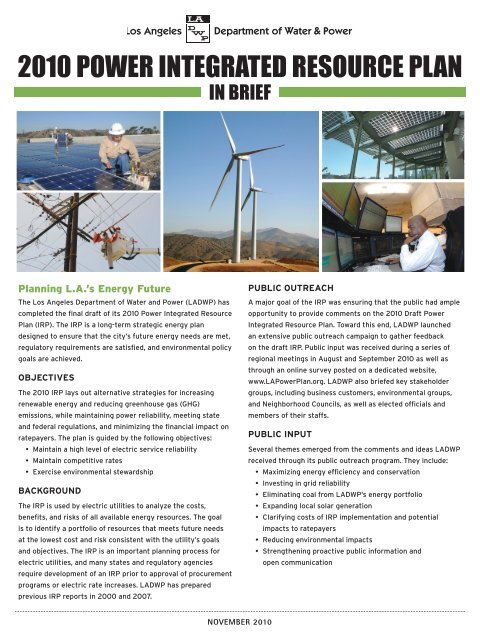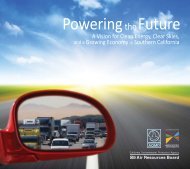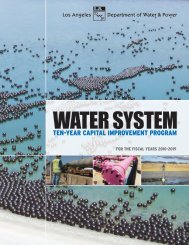DWP 2010 Power Integrated Resource Plan - LA Differentiated
DWP 2010 Power Integrated Resource Plan - LA Differentiated
DWP 2010 Power Integrated Resource Plan - LA Differentiated
You also want an ePaper? Increase the reach of your titles
YUMPU automatically turns print PDFs into web optimized ePapers that Google loves.
<strong>2010</strong> POWER INTEGRATED RESOURCE P<strong>LA</strong>N<br />
IN BRIEF<br />
<strong>Plan</strong>ning L.A.’s Energy Future<br />
The Los Angeles Department of Water and <strong>Power</strong> (<strong>LA</strong><strong>DWP</strong>) has<br />
completed the final draft of its <strong>2010</strong> <strong>Power</strong> <strong>Integrated</strong> <strong>Resource</strong><br />
<strong>Plan</strong> (IRP). The IRP is a long-term strategic energy plan<br />
designed to ensure that the city’s future energy needs are met,<br />
regulatory requirements are satisfied, and environmental policy<br />
goals are achieved.<br />
OBJECTIVES<br />
The <strong>2010</strong> IRP lays out alternative strategies for increasing<br />
renewable energy and reducing greenhouse gas (GHG)<br />
emissions, while maintaining power reliability, meeting state<br />
and federal regulations, and minimizing the financial impact on<br />
ratepayers. The plan is guided by the following objectives:<br />
• Maintain a high level of electric service reliability<br />
• Maintain competitive rates<br />
• Exercise environmental stewardship<br />
BACKGROUND<br />
The IRP is used by electric utilities to analyze the costs,<br />
benefits, and risks of all available energy resources. The goal<br />
is to identify a portfolio of resources that meets future needs<br />
at the lowest cost and risk consistent with the utility’s goals<br />
and objectives. The IRP is an important planning process for<br />
electric utilities, and many states and regulatory agencies<br />
require development of an IRP prior to approval of procurement<br />
programs or electric rate increases. <strong>LA</strong><strong>DWP</strong> has prepared<br />
previous IRP reports in 2000 and 2007.<br />
PUBLIC OUTREACH<br />
A major goal of the IRP was ensuring that the public had ample<br />
opportunity to provide comments on the <strong>2010</strong> Draft <strong>Power</strong><br />
<strong>Integrated</strong> <strong>Resource</strong> <strong>Plan</strong>. Toward this end, <strong>LA</strong><strong>DWP</strong> launched<br />
an extensive public outreach campaign to gather feedback<br />
on the draft IRP. Public input was received during a series of<br />
regional meetings in August and September <strong>2010</strong> as well as<br />
through an online survey posted on a dedicated website,<br />
www.<strong>LA</strong><strong>Power</strong><strong>Plan</strong>.org. <strong>LA</strong><strong>DWP</strong> also briefed key stakeholder<br />
groups, including business customers, environmental groups,<br />
and Neighborhood Councils, as well as elected officials and<br />
members of their staffs.<br />
PUBLIC INPUT<br />
Several themes emerged from the comments and ideas <strong>LA</strong><strong>DWP</strong><br />
received through its public outreach program. They include:<br />
• Maximizing energy efficiency and conservation<br />
• Investing in grid reliability<br />
• Eliminating coal from <strong>LA</strong><strong>DWP</strong>’s energy portfolio<br />
• Expanding local solar generation<br />
• Clarifying costs of IRP implementation and potential<br />
impacts to ratepayers<br />
• Reducing environmental impacts<br />
• Strengthening proactive public information and<br />
open communication<br />
NOVEMBER <strong>2010</strong>
RECOMMENDED ACTIONS<br />
As a result of the public outreach, <strong>LA</strong><strong>DWP</strong> developed a series<br />
of high-level recommendations that attempt to respond to<br />
the public’s biggest concerns in the IRP goals and objectives.<br />
Following are the high-level recommendations, along with some<br />
of the specific actions that will be taken and outcomes that will<br />
result.<br />
• Invest in grid reliability to reduce the number and length<br />
of power outages. This recommendation identifies such<br />
performance metrics as replacing 92,000 power poles and<br />
45,600 electric transformers over the next 20 years.<br />
• Modernize power plants to improve reliability and<br />
integration of renewable energy. Action items include<br />
building six quick-start generating units at Haynes<br />
Generating Station, developing ultra-efficient generating<br />
units at Scattergood Generating Station, and replacing<br />
ocean water cooling systems with dry cooling. This action<br />
will reduce the use of ocean water by 82% – enough to fill an<br />
Olympic-sized pool 2,400 times every day.<br />
• Transition away from coal earlier than required to reduce<br />
GHG emissions. Specifically, the IRP recommends divesting<br />
ownership in Navajo Generating Station in Nevada by 2014,<br />
which would reduce <strong>LA</strong><strong>DWP</strong>’s GHG emissions by 10.5 million<br />
metric tons (MMT)—roughly the same as removing 350,000<br />
cars from the road.<br />
• Invest in Smart Grid technology such as two-way<br />
automated meters, and automated distribution and<br />
transmission lines. Through Smart Grid investments,<br />
<strong>LA</strong><strong>DWP</strong> customers will be able to better manage their<br />
energy use. Such investments also improve reliability,<br />
provide instantaneous outage information and increase<br />
efficiency.<br />
POTENTIAL RATE IMPACTS<br />
<strong>LA</strong><strong>DWP</strong> estimates that the recommended major initiatives<br />
will cost approximately $23 billion over the next 10 years. The<br />
total costs for these initiatives along with basic generation,<br />
transmission and distribution system is expected to be about<br />
$45 billion through 2020. Corresponding electric rates are<br />
estimated to increase about 5% to 8% per year for the next<br />
five years, and average 3% to 4% per year over 20 years.<br />
NEXT STEPS<br />
Recognizing that the IRP is an ongoing public process, <strong>LA</strong><strong>DWP</strong><br />
will update the document yearly and hold public outreach<br />
meetings to produce a new version every two years.<br />
The full IRP document is posted online at www.<strong>LA</strong><strong>Power</strong><strong>Plan</strong>.org.<br />
A summary of the public comments heard during the public<br />
outreach process is also posted at www.<strong>LA</strong><strong>Power</strong><strong>Plan</strong>.org.<br />
• Increase renewable energy to 33% of <strong>LA</strong><strong>DWP</strong> retail power<br />
sales by 2020, reducing <strong>LA</strong><strong>DWP</strong>’s GHG emissions by 19<br />
percent.<br />
• Expand local solar generation to 40% to 50% of the city’s<br />
total solar output. Efforts include building solar on City<br />
properties and establishing a feed-in tariff program. This<br />
recommendation will produce 300 to 360 megawatts (MW)<br />
of solar—enough to power 100,000 homes—boost the solar<br />
industry and jobs in Los Angeles, improve reliability and<br />
reduce grid congestion during hours of highest energy use.<br />
GHG emissions will decline by at<br />
least 38% over the next 20 years<br />
as a result of all IRP actions.<br />
• Reduce energy use by 10% through energy efficiency and<br />
conservation programs, such as rebates for energy-saving<br />
appliances and public education. <strong>LA</strong><strong>DWP</strong> expects to save<br />
and additional 1,960 gigawatt-hours (GWH) of electricity<br />
by 2020 through these efforts. That equates to removing<br />
212,000 cars from the road or 327,000 homes from the<br />
grid. It also means avoiding the need for 780 MW of new<br />
generation, transmission, and distribution facilities.<br />
11/10





